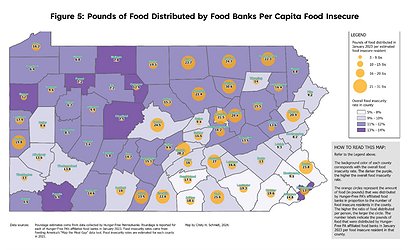Petty Officer 2nd Class William Sykes | U.S. Fleet Cyber Command (The Center Square)
Pa. residents face many challenges when it comes to obtaining food
Pennsylvania’s network of food banks and pantries to aid those in need is robust, but transportation limits, a dearth of volunteers and unmet need still prove to be problems in rural areas.
A recent study published by the Center for Rural Pennsylvania estimated that 10% of Pennsylvanians lack access to adequate and affordable food. Food insecurity nationally, CRP Assistant Director Laura Dimino noted, spiked with COVID-19, then dropped below pre-pandemic levels.
“We are still, as of 2022, nationally the estimate of rural households with food insecurity is around 15%, and 12% in urban areas,” Domino said. “We’re up a little bit again, probably due to inflation and other considerations.”
Poor families are getting squeezed.
“In 2022, food prices increased by 9.9%, and in 2023, they increased by an additional 5.8%,” the report noted. “Thus, families saw their benefits reduced as their purchasing power also plummeted.”
In interviews with 22 food banks, 35 partner agencies and 65 food bank users, researchers found that those who got food assistance had positive experiences using banks and pantries, and could get more than meals.
“For service recipients, pantries are not only a source of food but also a locus of anti-poverty assistance,” researchers wrote, with food banks also connecting residents to other government assistance programs along with help for rent, utilities, and transportation.
But much work remains to be done.
“At the top of the list of challenges is food banks and pantries’ need for increased funding to purchase more food (quantity) and fresher, more nutritious food (quality),” researchers wrote. “Rural service recipients face barriers to obtaining the quality and quantity of food they need, due to limits around when (time), where (place), and how (distribution model) they can receive emergency food.”
Roughly half of the food comes through state and federal programs — with various eligibility requirements — and half from private sources. The result is a complicated network of who can get what kind of help.
“Eligibility guidelines may be different across the board,” Domino said. “When someone comes in, they need to figure out: Is this person or household eligible for only this food, or that food? … A lot of people may not meet the poverty-level guidelines set up for some government programs; they can only have private donor food. This creates a difficult distribution problem.”
If the state relaxed or eliminated those bureaucratic burdens, she said, it could make the day-to-day easier on the ground.
Getting food to remote communities has also been a challenge, the report noted. In some counties with higher need, the average recipients may get much less food than better-off areas, as Figure 5 in the report showed.
 Courtesy of the Center for Rural Pennsylvania/The Center Square
Courtesy of the Center for Rural Pennsylvania/The Center Square
Workers to organize, distribute, and run the banks are scarce in some places, too. Some rural counties struggle to maintain a stable volunteer base to staff the food pantries.
“Due to these challenges and barriers, service recipients continue to face food insecurity, despite receiving emergency food,” the report noted. “Fifty-two percent of interviewees told us they cut the size of their meals, skip meals, eat less than they should, or go hungry. Food banks also report that thousands of food-insecure residents in each county are not being served at all.”
Though the focus on food assistance tends to fall on children and young families, assistance programs for them means they may not be the most at risk.
“Not that children aren't at risk, but, based on the interviews, it seems that seniors are probably more at risk,” Domino said. “There’s a program, senior food boxes; there’s one estimate that only 10% of seniors in some locations are even taking advantage of it.”